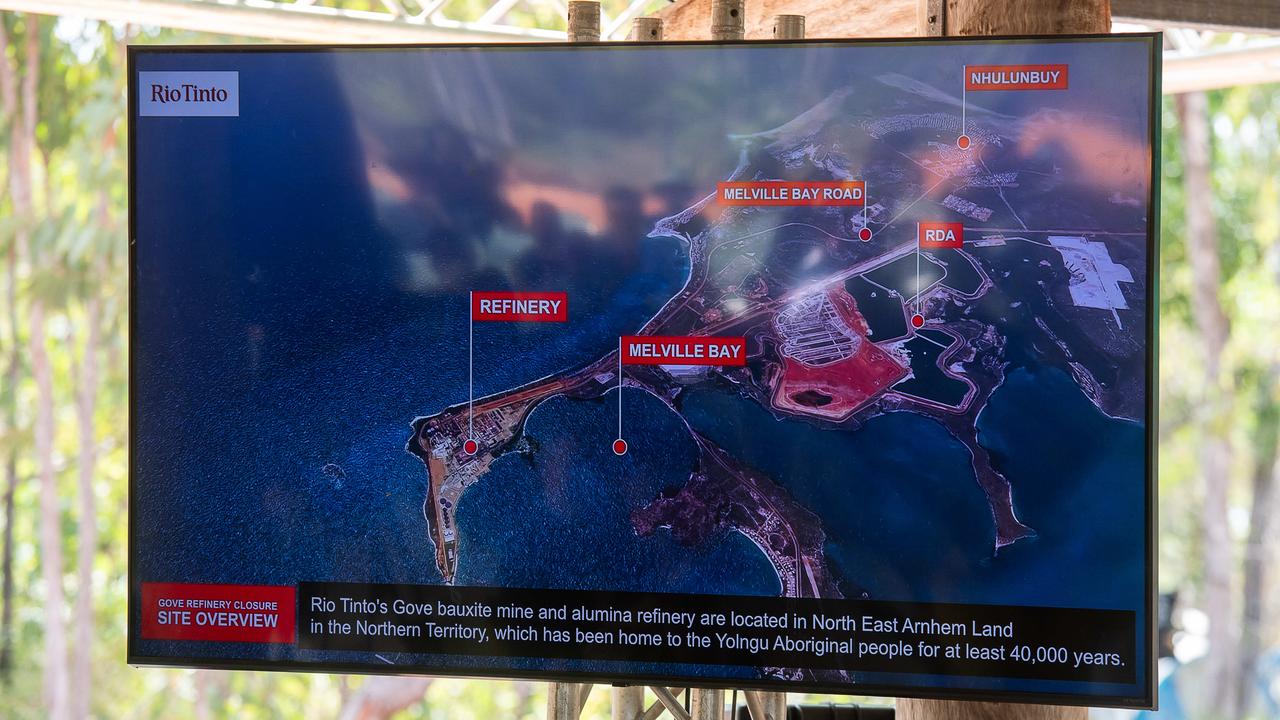Garma Festival 2023 outlines for Nhulunbuy post Gove mine
The largest demolition project in the Southern Hemisphere is taking place in a remote slice of the Territory, with the equivalent of three Sydney Harbour Bridges being torn down. See how they plan to rebuild.
News
Don't miss out on the headlines from News. Followed categories will be added to My News.
The people of East Arnhem face a ticking clock to diversify before the closure of a 55-year-old bauxite mine potentially wipes out 50 per cent of the region’s economy.
Yothu Yindi Foundation chair Djawa Yunupingi said the Yolngu people were determined to see new businesses flourish ahead of the expected closure of the Rio Tinto Gove mine in 2030.
At the Garma Festival on Saturday, Mr Yunupingi said the 2011 agreement with the Gove Mine was the “best thing to happen to our people”, as it secured more employment, and payments to the Gumatj Future Fund and the Rirratjingu Aboriginal Corporation.
But with fewer than eight years left until the bauxite mine closes, Mr Yunupingu said his people had to look to a post-mining future.

Gumatj Corporation chief executive Klaus Helms said mining and related industries accounted for 50 per cent of all economic activity and 20 per cent of jobs in East Arnhem.
Mr Helms was frank in his assessment for the future, pressing the urgent need to diversify into new business ventures including surveying, tourism and the space industry.
He said not every new industry would succeed, and time was running out to create a workable economic model before the mining royalties ended in 2030.
“We don’t have much. When Rio leaves – and they will – we’ve got Nhulunbuy …(but) what else is there?,” he asked.
“If we’re not on the ball of getting it done in time, we’re going to find ourselves in trouble.
“We’ve already prepared ourselves, we’re at least got a window now where we can do this.”
Mr Helms said the closure of the mine had already presented new economic opportunities, allowing for Yolngu businesses specialising in mine rehabilitation and mining services to develop.

Rio Tinto Australia chief executive Kelly Parker said the plan to clean up the Gove mine was “one of the largest environmental rehabilitations projects in history”.
Ms Parker said 9000 trees were being replanted, while the dismantling of the refinery site was currently the largest demolition project in the Southern Hemisphere.
“It’s the equivalent of dismantling three Sydney Harbour Bridges,” she said.
Mr Helms said while some were “aghast” to see the bauxite refinery – which has been closed since 2017 – being dismantled, “it brings our people great joy seeing it pulled down”.
He said the Yolngu people were looking to reuse the suitable assets, including the chemical fuel tanks, ports, warehouses, roads and administration buildings.
“If we see no value in it, if we see liability in it, that’s what it’s going to be – scrap,” Mr Helms said.
But with 50 per cent of their economy mining-based, Mr Helms said radically new business ventures were being explored.
Alongside this was the hopeful expansion of education facilities, with the Dhupuma Barker school, and a greater role in Australia’s future space industry at the Arnhem Space Centre.
Mr Helms said plans were in place to expand the space centre onto rehabilitated Rio Tinto sites – transforming Nhulunbuy from a mining services hub into an astronomical services hub.
“Will it happen quickly? No. Will it happen? I hope so in the future for the people here,” he said.

Mr Helms said practically for the first time, the region was thinking about tourism by opening up a cattle farm 110km out of Nhulunbuy to caravans and campers.
“We’re working on every avenue,” he said.
“But we have to be prepared for some things to collapse, but not take down the whole company.”
Mr Helms called on other agencies, particularly the Territory Government, to work with Aboriginal communities to find the solutions.
“We’re up to the challenges, tell us what they are, tell us how we can help and we’ll do it,” he said.
“But if you don’t tell us it will just keep the roadblocks up.”
With 10 per cent of Nhulunbuy’s population directly employed by bauxite mining according to the Australian Bureau of Statistics, Mr Helm said realistically the town would shrink by 2030 but was hopeful it would not “collapse”.
After 55 years of mining on Yolngu land the corporation chief said the people of East Arnhem “love bauxite” – but the relationship with the Gove mine has not always been easy.
In May the Gumatj clan won a landmark Federal Court victory, after it found the commonwealth failed to act “on just terms” when it authorised Nabalco to begin its bauxite mining operation in 1968.
Legal experts have previously estimated the claim could be worth up to $700m and could open the door for similar compensation cases for decisions by the commonwealth in the Territory from 1911-1978.
Federal Attorney-General Mark Dreyfus lodged a special leave application in the High Court to challenge the Federal Court ruling.
More Coverage
Originally published as Garma Festival 2023 outlines for Nhulunbuy post Gove mine









